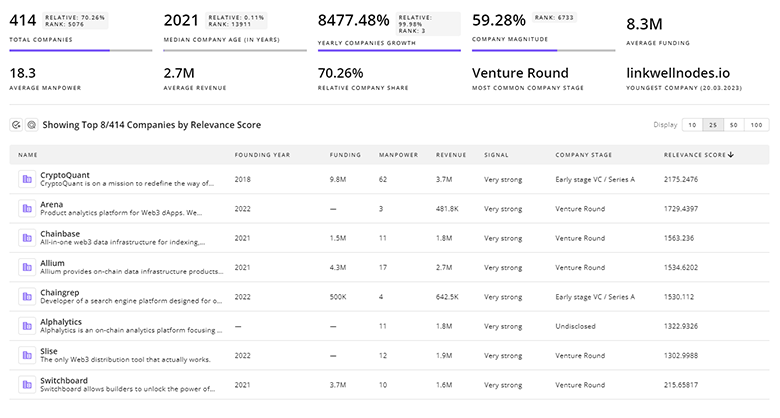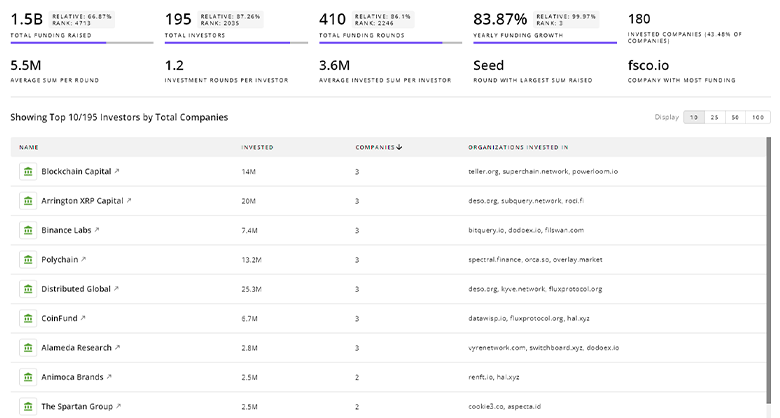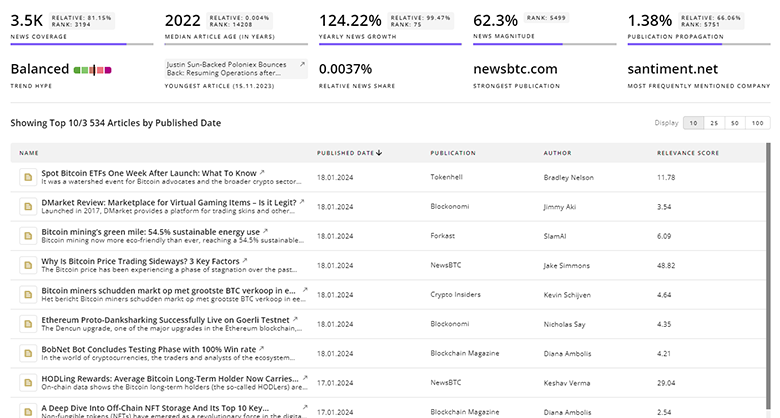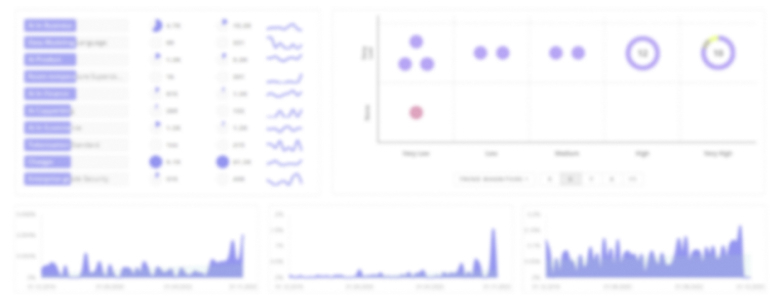
Multi Signature Report
: Analysis on the Market, Trends, and TechnologiesThe multi-signature market is moving from niche cryptographic tooling to broadly applied security infrastructure for digital assets and enterprise workflows; the internal multi-signature data shows 502 companies and total funding of approximately $7.34 billion supporting the topic, indicating meaningful commercial scale and investor interest. Growth concentrates where multi-party control solves operational, audit, and compliance gaps (treasury management, escrow, DAO governance) while advanced cryptographic approaches (MPC/TSS/Schnorr aggregation) shrink friction and on-chain cost.
We last updated this report 65 days ago. Tell us if you find something’s not quite right!
Topic Dominance Index of Multi Signature
To gauge the impact of Multi Signature, the Topic Dominance Index integrates time series data from three key sources: published articles, number of newly founded startups in the sector, and global search popularity.
Key Activities and Applications
- Enterprise treasury and non-custodial custody: businesses adopt M-of-N multisig and MPC wallets to remove single-key failure and create auditable approval flows for large holdings MPCWallet / MPCVault profile.
- Decentralized governance (DAO treasuries): multisig and threshold signatures gate protocol upgrades and fund disbursements, providing cryptographic enforcement of governance votes.
- Escrow and peer-to-peer settlement: atomic, multisig-based escrow replaces trusted intermediaries in marketplace and OTC flows, reducing counterparty risk and settlement latency.
- Cross-chain asset control and bridges: adaptor signatures and threshold schemes enable coordinated spending across chains to prevent single-chain custody exposure during transfers.
- High-assurance identity-bound signing for regulated workflows: biometric and identity proofing combined with multi-signer policies for high-value contracts (financial, healthcare, government) increase evidentiary strength of signed records digital signature market forecasts and regulatory drivers.
Emergent Trends and Core Insights
- Threshold signatures and MPC move multisig off-chain while yielding single compact signatures on-chain, reducing gas and improving privacy; patent filings emphasize t-of-n aggregation and secret sharing as priority innovations.
- Integration with identity and compliance stacks: custodians and enterprise wallets add KYC, role-based approvals and audit trails to meet AML and corporate governance demands, increasing enterprise adoption velocity market demand for regulated e-signatures and identity integration.
- Convergence of MPC, TEEs, and distributed key management: hybrid designs pair MPC protocols with hardware TEEs (Intel SGX / AMD SEV) to trade performance, threat model, and recovery guarantees—this pattern appears repeatedly in product descriptions and patent claims MPC + TEE adoption examples: MPCVault, Safeheron integration notes.
- Cross-domain use cases expand beyond crypto: e-signatures anchored on blockchains, biometric video evidence for signing, and document notarization are converging with multisig logic to create auditable multi-party approvals in traditional industries blockchain-anchored eSignatures and market growth projections VeriDoc Sign blockchain eSignature solution.
- Security economics and UX pressure: vendors optimize for lower operational friction (one-click approvals, policy engines) while reducing attack surface (phishing-resistant flows), a necessary balance for wider consumer and enterprise uptake digital signature market adoption drivers and UX focus.
Technologies and Methodologies
- Schnorr / MuSig aggregation: enables multiple signers to produce a single, compact signature that improves privacy and reduces on-chain footprint Schnorr/MuSig research and ROAST developments.
- Threshold Signature Schemes (TSS): cryptographic primitives that let t participants jointly produce a standard signature without exposing secret key material; common in institutional wallet designs.
- Multi-Party Computation (MPC) with SDKs and networks: off-chain distributed signing that supports device heterogeneity and recovery workflows; market offers MPC SDKs and hosted MPC services for custody use cases MPC market sizing and adoption; MPC infrastructure trends.
- Adaptor signatures and atomicity primitives: enable conditional payments, atomic swaps and cross-chain constructions that rely on multisig-style threshold enforcement.
- Biometric and identity binding for legal attestations: video evidence, liveness checks, or qualified identity wallets combined with multi-approver signatures strengthen non-repudiation in regulated contexts SelfieSign video + eSignature approach and identity binding market drivers for identity in eSignature.
Multi Signature Funding
A total of 155 Multi Signature companies have received funding.
Overall, Multi Signature companies have raised $7.5B.
Companies within the Multi Signature domain have secured capital from 529 funding rounds.
The chart shows the funding trendline of Multi Signature companies over the last 5 years
Multi Signature Companies
- TotalSig — TotalSig offers a multichain multisignature wallet built on MPC technology that targets Web3 teams and cross-chain asset management; it supports multiple blockchains, tokens, and NFTs in a single app and highlights low operational costs for multisig flows, positioning it for DAOs and crypto-native businesses that need low friction multisig treasury controls TotalSig profile.
- MPCVault — MPCVault sells a non-custodial, multi-chain, multi-asset team wallet that combines MPC and TEE runtime options (Intel SGX, AMD SEV) to reduce single-point risk and enable hierarchical team controls; the company reports adoption by trading desks and Web3 teams and emphasizes encrypted end-to-end communication for zero-trust operations MPCVault profile.
- Asigna — Asigna focuses on native Bitcoin multisig and vault primitives within the Stacks/Bitcoin stack, offering privacy-preserving multisig vaults, batch transactions, and integration plans for ordinals and cross-ecosystem tooling; the project targets users seeking personal and DAO multisig on Bitcoin-centric rails and lists seed funding to scale development Asigna profile and positioning.
- VeriDoc Sign — VeriDoc markets a blockchain-anchored eSignature verification product that anchors document hashes to public ledgers and offers quick mobile verification via QR scanning; the solution targets organizations that need tamper-proof audit trails and simpler verifier workflows for legal and commercial documents VeriDoc Sign profile.
- Cygnetise — Cygnetise provides a blockchain-backed authorized signatory management platform focused on corporate signatory lists and bank mandates; the SaaS product reduces manual administration, produces immutable audit trails, and targets financial institutions and large corporates that need a single source of truth for signing authority Cygnetise profile and value proposition.
Enhance your understanding of market leadership and innovation patterns in your business domain.

513 Multi Signature Companies
Discover Multi Signature Companies, their Funding, Manpower, Revenues, Stages, and much more
Multi Signature Investors
TrendFeedr’s Investors tool offers comprehensive insights into 1.5K Multi Signature investors by examining funding patterns and investment trends. This enables you to strategize effectively and identify opportunities in the Multi Signature sector.

1.5K Multi Signature Investors
Discover Multi Signature Investors, Funding Rounds, Invested Amounts, and Funding Growth
Multi Signature News
TrendFeedr’s News feature provides access to 1.9K Multi Signature articles. This extensive database covers both historical and recent developments, enabling innovators and leaders to stay informed.

1.9K Multi Signature News Articles
Discover Latest Multi Signature Articles, News Magnitude, Publication Propagation, Yearly Growth, and Strongest Publications
Executive Summary
Multi-signature has evolved from a technical curiosity into a practical control primitive for modern digital commerce: institutional custody, DAO governance, escrow, and regulated document workflows each use multisig logic to replace single-point trust with verifiable, auditable thresholds. The commercial opportunity sits where cryptography, identity, and workflow automation intersect: providers that combine efficient cryptographic schemes (MPC, TSS, Schnorr aggregation) with enterprise features (identity binding, policy engines, auditability) will capture regulated demand and treasury budgets. Conversely, narrow single-feature vendors must either integrate vertically or specialize in defensible niches (e.g. bank mandates, Bitcoin-native vaults) to remain viable. Organizations selecting multisig solutions should evaluate the protocol tradeoffs (on-chain fee and privacy vs off-chain performance and recovery), alignment with compliance requirements, and integration of identity/UX features that drive adoption across non-technical signers.
We value collaboration with industry professionals to offer even better insights. Interested in contributing? Get in touch!











